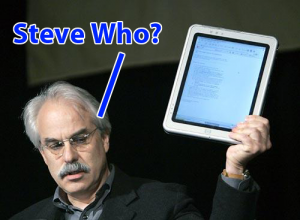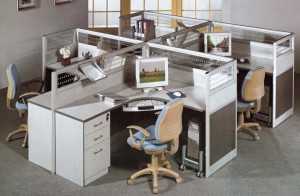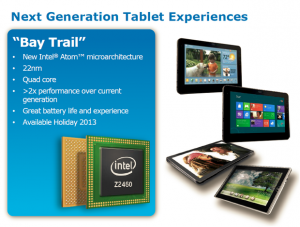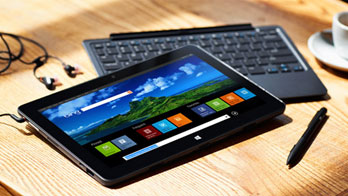A new generation of tablets with full-featured Windows will win the war of attrition against both iOS and Android.
Put on your “suspend disbelief” hats and pull up a chair: I’m about to tell you why the tablet is dead – at least Steve Job’s vision of the tablet.
Whence the tablet?
Less than 4 years ago, Apple unveiled a product that would fundamentally change the landscape of portable media and entertainment. The first-generation iPad took a decades-old concept, slate-format computing, and made it truly work for the masses. In fact, this wasn’t Apple’s first kick at tablet can: a dozen or so people bought the Newton MessagePad from 1993 to 1998, and Apple even prototyped a tablet-form PowerBook but shelved it over concerns of leeching sales from the Newton.

The TC1100 and it’s generation were the first full-featured windows tablets, but met with a cool reception due to the clunky stylus-based input.
Windows users had access to tablet-format computing since about 2000, though it was a pretty sup-par experience until the release of the Pentium-M toting TC1100 from Hewlett-Packard. Even with the excellent keyboard and docking station, though, the TC1100 and its contemporaries suffered from poor battery life, pokey response, and a touchscreen that required a very specific stylus to work. The tablet PC was generally relegated to very specific, high-portability functions like those of sales people, site inspectors, or medical professionals.
On the heels of their tremendous success with the iPhone, Jobs & Co. released their own take on the tablet. It really was revolutionary and also unexpected at the time… most pundits predicted an OSX-toting slate computer, and were flabbergasted to learn that the new tablet would be running the same operating system as the iPhone (iOS, – with name on loan from Cisco).
Well, of course the internet nerd contingent – all of whom wanted OSX on a slate – completely wrote-off the new device, which was dismissed throughout the tech blogosphere as no more than a ‘maxipod’ and doomed to failure. Well boy oh boy did Jobs prove them wrong.
Getting it right.

The iPad gave users something new: light, portable entertainment with a great battery and easy interface.
Apple had either realized or accidentally stumbled upon an important fact: people at home in the evenings wanted and were willing to pay for a lightweight portable screen they can surf the web on, use to catch up on facebook, or play solitaire. This is very important – read that sentence again. More importantly, this was a separate device – not their laptop or phone – that they were willing to drop >$500 on as a personal entertainment device. This kind of tablet came to be known as a ‘media consumption device’, largely due to the fact that data input capabilities were minimal/clunky and productivity apps were rudimentary at best (if available at all).
Because people were willing to shell out for a separate media consumption device, the iPad enjoyed meteoric sales, reaching new heights year after year. The device truly changed public perception of web and media accessibility at home, and sales have only now started to level off as competition increases and people have saturated their tablet needs.
Meanwhile in the PC world …
In the background, another phenomenon was taking place in the PC world: Chips were not getting “faster” at the breakneck pace that was so prevalent through the 80’s and 90’s. Instead of the megahertz race of yesteryear, new CPU designs from both Intel and AMD were focused on adding new features such as:
- Integrating GPU capabilities into the same die as the CPU
- Dramatically reducing power consumption
- Accelerating Virtualization at the CPU level (ie Intel’s VT extension set)
The upshot of this change in focus in the CPU industry was that as time passed, older and older PC’s could perform the same productivity tasks as newer ones, without the almost mandatory 3-year replacement schedule of earlier generations. Also, PC’s and laptops were no longer a novelty item – they had become a necessity for home and office, and people weren’t excited about replacing them anymore. It became a mundane life expense, like buying a new commuter car, which you delayed as long as possible.
The personal computer is dead!
PC sales started declining in 2009, and have been slowing down since. Why? Well, people just don’t have need of the latest greatest desktop/laptop every few years like they used to. The old gray mare in the corner is still capable of running the latest version of Word, researching stuff online, and playing The Sims. So even if Mom or Dad needed a new rig for work, little Johnny and Sally could still use the hand-me-down for a number of years without too much concern. This of course means fewer new computers under Christmas trees, and fewer new laptops for back-to-school.
The trend in dropping sales started roughly around the same time as the massive proliferation of the superphone (an even smarter smartphone?) and the introduction of the media-consumption tablet.

PC sales slow as tablet sales grow, but the trends are not as related as you think.
Correlation is not causation, but pundits love to show graphs and trends and tell you that product A is replacing product B etc. The fact is, though, there is literally no evidence – zero, nadda, nil – that the rise in sales of smartphones and entertainment-centric tablets has had any causal affect on the sale of PC’s. We do see the sales of one sector go up, an the other go down… this is pretty clear. What is also clear, though is the fact that people have not taken up using their phones and tablets for input-heavy productivity tasks such spreadsheets, building presentations or writing up proposals and quotes. These devices simply lack the input capabilities and the robust software tools required to efficiently get in a good day’s work.
And so, famously, the “death of the PC” was proclaimed by Jobs in 2010, and the reverberating masses echoed his words far and wide. People talked of ‘watershed’ moments when RAM sales for portables outpaced those of PC’s in 2012 and how the computing world would never be the same.
… Except not.
Now let’s fast forward a few years to end 2013/early 2014. Tablet sales have been extremely healthy, but growth is starting to level off (especially for the iPad). Is this due to stronger smartphone sales? A resurgence in the PC world? Well, if you think so, I would challenge you to produce the hard evidence. Jobs (probably) knew it, but noone else seems to realize that these are completely different market segments. The tablet segment is simply becoming saturated. If the tablet you bought 2 years ago does everything you need it to, why buy a new one?
Also, now that we’re a few generations in, tablet processors and software are really great at rendering busy websites and processing other complex media (ie playing movies). The Mom/Dad trickle down to Johnny/Sally is already becoming saturated too, so a slowdown in growth is of course only natural. The tablet you buy today will last you much longer than the crappy Tegra 2 tablet you bought in 2011. This of course is precisely the trend we saw with PC’s starting half a decade ago.
The Landscape Today
In my own tech consultant role, I’m lucky to visit and work in many and varied offices. I enjoy a lot of visibility of what small to medium businesses (200 or less employees) in many industries are using for computing.

The vast majority of offices still look like this: a PC at every desk, though the average age of those PC’s is increasing.
What I see is this: your local Avon lady uses a tablet at night to catch up on Facebook (which she uses to promote her business), but she is on her junky old chicken-grease-coated PC during the day to work out spreadsheets, her geographies, quotes, and to submit those coveted, rare orders. She hasn’t updated her HP laptop in 4 years, and doesn’t need to because it still works on all the company’s systems. Avon wants to make it as easy as possible for their field agents, so everything sales agents need to communicate with corporate runs on Windows XP with 512 MB of RAM.
When I walk into a larger office, maybe 80 people at an accounting out-sourcer (you wouldn’t believe how many of these there are), all the marketing people have iPhones, all the tech guys have android phones, but every desk in that building has one thing in common: some kind of Windows desktop. The sales guys may have Apple tablets, or even Android or Windows tablets for presentations, but invariably, they all still rely on old fashioned PC’s for day-to-day work. The average age of the PC’s I see in theses offices is increasing, too, as is the age of the software with many shops still running Office 2007 or even 2003.
The more things change, the more they stay the same
The business landscape and sales trends paint a pretty clear picture, and it’s really not surprising at all:
- Businesses, large and small, still rely (almost) exclusively on desktop or laptop computers for productivity
- Consumers at home still need PC’s to interface with work, do their taxes, and manage years of collected data and documents
- Consumers at home want a convenient 8″ or 11″ tablet for relaxation or “media consumption”
- Both business and home consumers tend not to buy new PC’s or tablets if their current one does what they need, as seen first by the leveling off in PC sales, and now with tablets.
People need a PC for work and want a tablet for play, and are willing to pay for both.
As mentioned above, the tech blogosphere was quite shocked in 2010 to find the newly-introduced iPad running iOS rather than OSX (the full desktop OS). But Job’s cheesy car-salesman grin kept attention away from his dirty little secret: It wasn’t that Apple didn’t want to put OSX on the iPad, the fact is that they couldn’t. The technology didn’t exist yet to have an x86-compatable chip in a very slim light tablet with any kind of performance or battery life. These tablets did exist, actually, running windows, but the experience was poor and costs were twice what Apple was promising with the iPad.
And almost prophetically, the same CPU trend which led to slowing PC sales – that led to the proclamation of it’s death – is about to breathe new life into the platform, and slowly, inevitably edge out competitors like Apple (iOS) and Google (Android).
When is a tablet not a tablet?
In the fall of 2013, Intel set loose a new generation of CPU that would finally bring x86 computing to tablets, while competing on par for battery and performance with its ARM nemesis. The Atom-series Bay Trail chips would completely outshine any ultra-portable x86 chip on the market, even offering laptop-grade computing and graphics at very low power consumption. The portable computing game had suddenly changed, and dramatically so.

The new Bay Trail CPU crosses a critical threshold for performance and power consumption, pushing x86 tablets into the mainstream.
Bay Trail (in its many tiers) allowed tablet manufacturers like Lenovo, Microsoft, Asus, Dell, and others to fabricate a tablet computer with excellent performance and battery life running full Windows 8.1. We’re not talking about Windows RT, which, like iOS and Android is limited by what’s available in an app store – this is full-blown x86 windows, which can run Quickbooks, Office, Photoshop, Quark, or any other Windows program you can throw at it. And with the expanded 3D capabilities, the higher-end tablets will even run current PC games at low settings.
Most of these manufacturers have an array of Bay Trail models, housing anything from an Atom-grade CPU right up to the Core i5 with full virtualization support (cause, you know, you really need to prototype that cluster on your tablet). What they all have in common though is thin, light build, excellent battery life, and that all-important x86 compatibility.
When people buy a tablet, they’re expecting media consumption: games, social media, and entertainment (a la Netflix). When they buy a laptop or PC, they expect to be able to run all of their current productivity programs, connect a CD-Rom drive, plug in a USB stick, etc. But what if they could do both on one device? Well, I guess that would mean that instead of spending twice, you could just spend the once…
BYOD’s place in all this
A common trend in business today is the so-called “BYOD” or bring-your-own-device paradigm. Initially, the plan was to have employees supply a cell phone of their choice, and the employer would cover some portion of the cost related to doing business.
Today, though, the BYOD trend has expanded to Laptops, including ultraportables. Many corporate roles involve some degree of travel or off-site work, and laptops are an absolute mainstay for many businesses. The ultraportable computer (ie MacBook Air, Ultrabook) is a significant portion of that notebook market.
And so the war begins
And here is where a new trend starts, an old one slowly dies off, and the PC – in a new body – secures its place as the primary productivity and entertainment device in your possession.
Imagine for a moment your 3-5 year-old laptop needs to be replaced. You spent about $1000 on it, and plan to drop maybe $800 on a new one. You use it for work, it’s usually with you when you’re out and about, and it has a ton of important work and personal data on it.
You’re also eyeballing a shiny new tablet for kicking back on the couch with in the evenings. It’s a pain to lug out your laptop just to catch up on facebook. Maybe you have an older iPad, but it’s slow and clunky and you want an upgrade.
So being a shrewd shopper, you go out to kick the tires on some new laptops and read up on some reviews before you commit to moving in for another 3-5 years. Poking around Best Buy, you pass right by the Windows tablets, “Who would want a windows tablet?”. But the keen sales guy takes you back over for a second look, saying it may be just what you’re looking for, and hands you a Dell Venue Pro 11 to play with.
This tablet is small – the same size and weight as an iPad 4, with the same battery life, too. But what’s this? A USB port?! Yes, and an SD card slot too for expanded memory. Now the bomb drops: it will run all the same programs as your current laptop, and it fits in the paper slot of your attache, and even with a keyboard cover costs less than the laptop you expected to buy.
So you take a chance, wowed by the portability and battery life – twice what you’re used to – and find that the new rig fully satisfies your productivity needs. From time to time, you plug in an external keyboard, or even plug it into your big monitor at home, but no matter where you go, your whole work environment and all your data are at your fingertips, and smaller than a pad of paper.
A couple of months later, you’re on the couch at home, and an ad pops up in the You-Tube window on your tablet. There’s a killer new tablet from Apple that’s smaller, lighter and faster than the last generation. This reminds you that it’s been 6 weeks since you picked up your old tablet, and that you no longer want or need another new tablet for your down time at home. The Windows tablet in your hands – running full windows – does more than any locked-down Android or iOS tablet ever could. You just have no need for a second device anymore.
When the dust settles
All of these trends together point to one inevitability: full-function productivity/entertainment tablets will slowly but surely replace the media consumption devices that dominate the market today. This will not be an overnight change: as BYOD buyers eventually replace their desktops and laptops with tablet-format PC’s, they will no longer need a media consumption tablet. Every imaginable program can be run on an x86 tablet, from productivity to social media to entertainment, and without reliance on a proprietary app store.
Another factor at play here is that the new Windows for tablets is actually really good compared to Android and iOS. Printing just works. File sharing just works. Plug in a USB stick, and bam – there are all your files. Need to VPN into work? Piece of cake. For all the problems with Windows in the past, this generation truly offers far more connectivity and convenience for tablet users than anything else out there.
The only way Android and iOS will survive this war of attrition is if they begin to offer x86 program support via an emulation mode that will be available in the next major generation of ARM processor. Why buy a tablet with 1 million apps available when you can buy one with 100 million apps available? Why settle for a facebook app when you can have the full browser-based experience? Why run a second-rate photo editor when you can run Photoshop? Just like Parallels and VMWare saved the OSX desktop from obsoletion in the workplace, a strong x86 compatibility mode could save Google and Apple tablets from a slow, painful but inevitable death.

Yes, that’s full Windows running on a tablet with the same dimensions and battery life as an iPad 4. Full USB, expandable memory and a removable battery make it a very attractive laptop replacement.
In the meantime, though, there are a slew of new tablets from Dell, Lenovo and Microsoft that put the full power of a PC in your hands at the same price point – and in the same form factor – as that iPad you wanted for Christmas. If you’re in the market for a new computer – or equally, a new tablet – these deserve your serious attention. Of the half-dozen clients we’ve seen here take the plunge just in the last 2 months, the feedback is loud and clear: “The tablet is dead. Long live the tablet!”